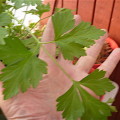My garden yields have been declining steadily for three years, so I decided to take action and have my soil tested. I used the services of Colorado State University, a land grant university in Ft. Collins. Here’s the good news:|
–Organic material was good, 7.3%. Normal is 4 to 6%.
–Nitrates were good at 11 ppm; normal is 10 ppm.
–pH was good at 7.2; neutral is 7.0
Here’s the bad news:
–Phosphorus was high at 225 ppm; normal is 50 ppm
–Potassium was extremely high at 951 ppm; normal is 100 ppm
–Salts were very high at 4.2 mmhos/cm. Normal is 2.0 mmhos/cm
The tester’s comments were: “The pH is suitable for plant growth. The salts are high. Plant growth may be reduced.” No kidding! My beds that once yielded 300 pounds of tomatoes yielded fewer than 10 pounds. I did some research and discovered that salts generally found in saline soils include NaCl (table salt), CaCl2 (calcium chloride), gypsum (CaSO4), magnesium sulfate, potassium chloride, caliche (calcium carbonate) and sodium sulfate. Salts in irrigation water and fertilizers accumulate in the soil over the years and create what’s called saline soils. These soils prevent plants from taking up water and nutrients like nitrates, reducing plant growth and yields. So how do you treat saline soils? You flush them out of the garden, and that’s easy for me because I have raised beds. I just turned on my soaker hoses for 4 hours and let the water run out of the bottom of the beds. To remove 80 percent of the salts, you need to put a foot of water on the beds. I will need to flush two more times before spring planting. But to see the results of the flushing, I will have the soil tested again so I know what amendments to add–in other words, what type of fertilizer to use, if any. Finally, I’m making some progress!
Have Your Soil Tested!











